|
Judicial Decision and Disposition Disposition In more than half (53%) of all adjudicated delinquency cases in 1995, formal probation was the most severe sanction ordered by the court.More than one-quarter (28%) of adjudicated cases resulted in the youth being placed outside the home in a residential facility.4 In 14% of adjudicated delinquency cases, the court ordered the juvenile to pay restitution or a fine, to participate in some form of community service, or to enter a treatment or counseling program -- dispositions with minimal continuing supervision by probation staff. In a relatively small number of cases (5%), the juvenile was adjudicated, but the case was then dismissed or the youth was otherwise released. In 43% of all petitioned delinquency cases in 1995, the youth was not subsequently adjudicated. Most of these cases (60%) were dismissed by the court. However, in 22% of nonadjudicated cases the youth agreed to some form of probation, in 16% of the cases the youth were given other dispositions, and 3% of all nonadjudicated delinquency cases resulted in voluntary out-of-home placements.
Although the likelihood of a delinquency case resulting in out-of-home placement declined between 1991 and 1995 for all four of the major offense categories, the number of adjudicated delinquency cases resulting in out-of-home placement increased 37% between 1986 and 1995 (table 15). During the 10-year period, placements increased more for drug offense cases than for person offense cases (91% versus 80%). Property offense cases in which youth were adjudicated delinquent and placed outside the home increased 12%, while out-of-home placements increased 46% in public order offense cases. 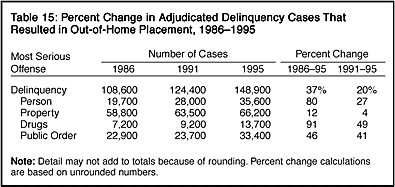 In 1995, 44% of all adjudicated cases that resulted in out-of-home placement involved property offenses, 24% involved person offenses, 22% involved public order offenses, and 9% involved drug law violations (table 16). Between 1986 and 1995, the offense profile of the juveniles involved in out-of-home placement cases changed somewhat. The proportion of out-of-home placement cases that involved person offenses increased, while the proportion involving property offenses declined. 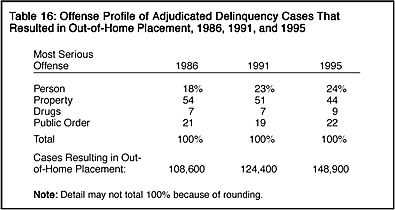 Formal Probation. Formal probation was the most restrictive disposition used in 283,300 adjudicated delinquency cases in 1995 -- 53% of all such cases handled by juvenile With the exception of drug offense cases, the likelihood of formal probation decreased only slightly (1 or 2 percentage points) for adjudicated delinquency cases between 1986 and 1995. The use of probation decreased from 55% to 53% for person offense cases, from 57% to 56% for property offense cases, and from 49% to 48% for public order offense cases. For drug violations, on the other hand, the use of probation in adjudicated cases fell 5 percentage points from 58% to 53%. Although the proportion of adjudicated cases resulting in a disposition of formal probation declined, the number of adjudicated cases that resulted in formal probation increased 43% between 1986 and 1995 (table 18). The number of person offense cases resulting in formal probation increased 86%, property offense cases increased 19%, drug offenses increased 111%, while those involving public order offenses increased 61%. 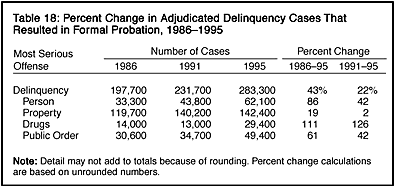 Half of the delinquency cases that resulted in formal probation in 1995 involved property offenses, 22% involved person offenses, 17% involved public order offenses, and 10% involved drug law violations (table 19). The offense characteristics of cases resulting in formal prbation changed somewhat between 1986 and 1995, with an increase in the proportion of cases involving person or drug offenses and a decrease in the proportion of cases involving property offenses. 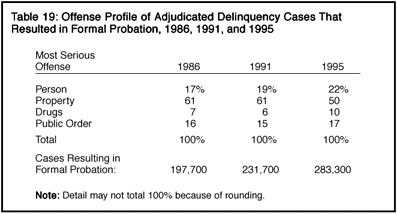 4 Most youth in out-of-home placements are also technically on formal probation. For this Report, however, case disposition is characterized by the most severe sanction. Therefore, cases resulting in an out-of-home placement are not included in the formal probation group.
|
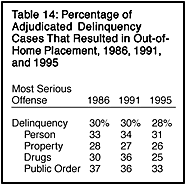 Out-of-Home Placement. Adjudicated juveniles were ordered to out-of-home placements in 148,900 delinquency cases in 1995 -- 28% of all adjudicated cases (table 14). Juveniles charged with property or drug offenses were less likely to be placed outside the home in 1995 than were those charged with person or public order offenses. Following adjudication, placement was ordered in 26% of property cases and 25% of drug cases compared with 31% of person offense cases and 33% of public order offense cases. The relatively high rate of placement among public order offense cases may be related to the fact that these cases included escapes from institutions, weapons offenses, and probation and parole violations.
Out-of-Home Placement. Adjudicated juveniles were ordered to out-of-home placements in 148,900 delinquency cases in 1995 -- 28% of all adjudicated cases (table 14). Juveniles charged with property or drug offenses were less likely to be placed outside the home in 1995 than were those charged with person or public order offenses. Following adjudication, placement was ordered in 26% of property cases and 25% of drug cases compared with 31% of person offense cases and 33% of public order offense cases. The relatively high rate of placement among public order offense cases may be related to the fact that these cases included escapes from institutions, weapons offenses, and probation and parole violations.  courts (table 17). Juvenile courts ordered formal probation in 56% of adjudicated cases involving property offenses, 53% involving person offenses, 53% involving drug law violations, and 48% involving public order offenses.
courts (table 17). Juvenile courts ordered formal probation in 56% of adjudicated cases involving property offenses, 53% involving person offenses, 53% involving drug law violations, and 48% involving public order offenses.